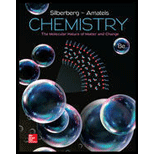
Concept explainers
(a)
Interpretation:
Binding energy per nucleon of
Concept Introduction:
Nuclear reaction: A nuclear reaction in which a lighter nucleus fuses together into new stable nuclei or a heavier nucleus split into stable daughter nuclei with the release of large amount of energy.
Nuclear binding energy: It is the energy that requires for the breaking one mole of nuclei of an element to its individual nucleons.
It can be calculated in
Nucleon: Nucleon is the collective name given to the members of the nucleus that is protons and neutrons.
The difference between mass of an atom and the sum of the masses of its proton and neutron is called Mass difference.
Binding Energy per Nucleon can be determined as follows:
(a)
Explanation of Solution
Given information is shown below,
Mass of Oxygen-16 is
In
- Calculate the mass difference:
As known the mass
Mass difference in
Mass difference in
- Calculate the binding energy per nucleon:
Number of nucleons in
Binding energy per nucleon of
Binding energy per nucleon of
(b)
Interpretation:
Binding energy per atom of
Concept Introduction:
Nuclear reaction: A nuclear reaction in which a lighter nucleus fuses together into new stable nuclei or a heavier nucleus split into stable daughter nuclei with the release of large amount of energy.
Nuclear binding energy: It is the energy that requires for the breaking one mole of nuclei of an element to its individual nucleons.
It can be calculated in
The difference between mass of an atom and the sum of the masses of its proton and neutron is called Mass difference.
(b)
Explanation of Solution
Given information is shown below,
Mass of Oxygen-16 is
In
- Calculate the mass difference:
As known the mass
Mass difference in
Mass difference in
- Calculate the binding energy per atom:
Binding energy per atom of
Binding energy per atom of
(c)
Interpretation:
Binding energy per mole of
Concept Introduction:
Nuclear reaction: A nuclear reaction in which a lighter nucleus fuses together into new stable nuclei or a heavier nucleus split into stable daughter nuclei with the release of large amount of energy.
Nuclear binding energy: It is the energy that requires for the breaking one mole of nuclei of an element to its individual nucleons.
Nuclear binding energy can be calculated by Einstein’s mass energy equivalence relationship that is,
The difference between mass of an atom and the sum of the masses of its proton and neutron is called Mass difference.
(c)
Explanation of Solution
Given information is shown below,
Mass of Oxygen-16 is
In
- Calculate the mass difference:
As known the mass
Mass difference in
Mass difference in
- Calculate the binding energy per mole:
Binding energy per mole of
Binding energy per mole of
Want to see more full solutions like this?
Chapter 24 Solutions
Chemistry: The Molecular Nature of Matter and Change
- Draw the mechanism for the substitution reaction converting an alcohol into an alkyl halide. If chirality is important to the reaction include it.arrow_forwardWrite, in words three different reactions we can use to make an alcohol.arrow_forwardDraw the reduction mechanism for the reduction of the aldehyde.arrow_forward
- What is the product of the reaction of XeF4 with H2O? Group of answer choices H2XeF2 H2XeF4 XeO3 H2XeOarrow_forwardWhile noble gas exerts the strongest London (dispersion) forces on neighboring atoms? Group of answer choices Xe Ar Kr Nearrow_forwardWhich of the following elements is corrosive to your skin due to that element breaking down C=C bonds? Group of answer choices fluorine iodine bromine chlorinearrow_forward
- What the best source of sulfide to use on a small scale in the lab? Group of answer choices thiourea H2S NaHS Na2Sarrow_forwardWhich of the following statements about sulfur is FALSE? Group of answer choices H2S is the product of an oxygen-depleted ecosystem. In the acid mine drainage reaction, FeS2 is a product. One allotrope of sulfur has the formula S20. In the environment, bacterial oxidation can convert S2− to elemental S or SO42−.arrow_forwardOf the following choices, which is the best reason that most materials DON'T spontaneously combust even though our atmosphere is about 21% oxygen? Group of answer choices The reduction of O2 in the gas phase (O2 + e− → O2−) is spontaneous. The reduction of O2 in acid solution (O2 + H+ + e− → HO2(aq)) is spontaneous. O2 is not a reactant in combustion. The O2 bond dissociation energy is 494 kJ/mol, leading to a high activation energy for combustion.arrow_forward
 ChemistryChemistryISBN:9781305957404Author:Steven S. Zumdahl, Susan A. Zumdahl, Donald J. DeCostePublisher:Cengage Learning
ChemistryChemistryISBN:9781305957404Author:Steven S. Zumdahl, Susan A. Zumdahl, Donald J. DeCostePublisher:Cengage Learning ChemistryChemistryISBN:9781259911156Author:Raymond Chang Dr., Jason Overby ProfessorPublisher:McGraw-Hill Education
ChemistryChemistryISBN:9781259911156Author:Raymond Chang Dr., Jason Overby ProfessorPublisher:McGraw-Hill Education Principles of Instrumental AnalysisChemistryISBN:9781305577213Author:Douglas A. Skoog, F. James Holler, Stanley R. CrouchPublisher:Cengage Learning
Principles of Instrumental AnalysisChemistryISBN:9781305577213Author:Douglas A. Skoog, F. James Holler, Stanley R. CrouchPublisher:Cengage Learning Organic ChemistryChemistryISBN:9780078021558Author:Janice Gorzynski Smith Dr.Publisher:McGraw-Hill Education
Organic ChemistryChemistryISBN:9780078021558Author:Janice Gorzynski Smith Dr.Publisher:McGraw-Hill Education Chemistry: Principles and ReactionsChemistryISBN:9781305079373Author:William L. Masterton, Cecile N. HurleyPublisher:Cengage Learning
Chemistry: Principles and ReactionsChemistryISBN:9781305079373Author:William L. Masterton, Cecile N. HurleyPublisher:Cengage Learning Elementary Principles of Chemical Processes, Bind...ChemistryISBN:9781118431221Author:Richard M. Felder, Ronald W. Rousseau, Lisa G. BullardPublisher:WILEY
Elementary Principles of Chemical Processes, Bind...ChemistryISBN:9781118431221Author:Richard M. Felder, Ronald W. Rousseau, Lisa G. BullardPublisher:WILEY





